Whether this is your first time going to a nail salon or your bazillion times, not all of us know every single nail terminology. Trust me; I don’t know half the shit is going on either. Haha.
This article exists to save you from bringing the wrong term to a nail shop and end up having jacked-up nails, get charged for a different service you didn’t request, or want something you just can’t put to word.
I can’t tell you how often a customer looking like a lost puppy when we ask if they want a regular polish or a Gel one.
It’s most helpful to glance through some terms to familiarize yourself with. I’ll explain like I’m five because not all of us are as knowledgeable as some of you do.
The basics – pedicure and manicure
Let’s start with pedicures because we all know I have a foot fetish. JK.
But when someone comes in and hola “mani, pedi,” it means they want both their hands and feet done, with pedicure referring for feet and manicure for hands.
The basic procedure of either pedicure/manicure is to clean up around your cuticles, cut, buff, give your nails a better shape, and always finish with nail polish. If you don’t want the polish, kindly tell your tech, “No, I don’t want none of your time, and no, I don’t want no scrub.” I’ll give you bonus brownie point if you get the preference.
That’s it. There are no artificial tips or powder or any of the like involved in a manicure, and a pedicure is strictly for feet. We’ll significantly reduce callus presence and smooth out your feet, but we’re not a doctor’s office with laser treatment and whatnot. The calluses won’t be gone in one day after being neglected for years, ya know?
It would help if you weren’t led to believe you’ll leave the salon sans callus first try because some cases are “serious.” Lol. Some shops don’t include scrubbing off the callus off the bottom of your feet unless it’s their premium pedicure packages. Don’t get your hopes up for a bargain when it comes to nail treatments. Some salons may not be willing to put their talented nail techs to work on a deal that doesn’t pay off. After all, you wouldn’t expect a Michelin-starred restaurant to cook you a gourmet meal for the price of fast food, would you? It’s all about the value, baby.
So it’s an excellent idea to ask beforehand. It also depends on the seasons that things change around quite a bit. What you see on the menu is not always what you get. My advice is to ask what’s on and off the menu—wink wink.
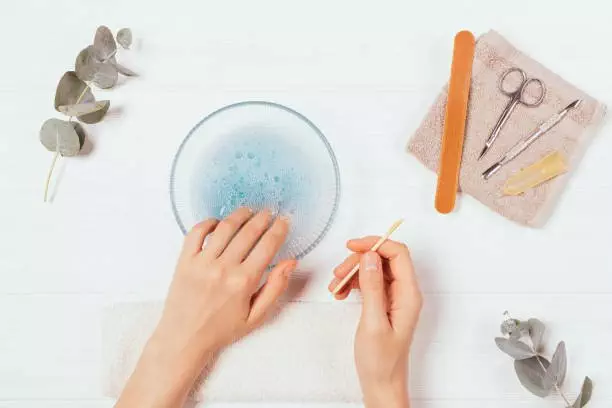
Paraffin wax
I wish I start counting how many times I get asked about paraffin wax daily or how many times I have to help my coworkers when their customers ask.
Paraffin treatment is often covered in premium pedicure packages; and some shops put it as an add-on. It’s a warm wax base including essential oils, minerals, some vitamins mold onto your hands/feet to penetrate deep onto your skin, moisturize dry/crack skin.
The warm heat opens up your pores and penetrates deeply to pull out all the dead skin cells once the wax solidifies. Hence your hands/feet feel so much softer and smoother the moment we take those wax off.
It also eases muscle pain and stiff joints because the heat helps with blood circulation. It can further weaken the calluses to some degree.
I probably pull all this information out of my ass, but it makes some sense, right?
The paraffin is odorless and colorless, but most shops would use scented versions so they’ll be tinted to the color closer to the original ingredients. For instance, the lavender wax will have a purple tint, and the peach wax will be orange, etc.
This type of wax is not from your candles. Lol. Unless you have a paraffin wax warmer to melt them properly at a specific temperature, you’ll run a massive risk of hurting yourself. Cheap wax warmers will burn out after a few tries as well. My suggestion is don’t even think about trying out at home; it’s not worth the hassle. You can send that Amazon purchase back to the sender if it doesn’t quite cut the mustard, but can you get a reimbursement for those fiery paws or toasty tootsies of yours?
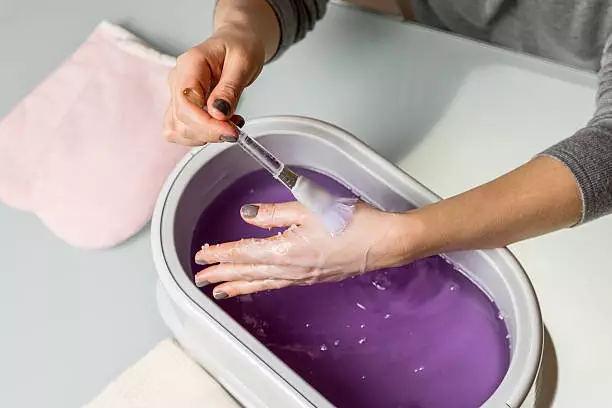
French tips
“French tips” means the white polish is painted across the tips of the nail to create a nice contrast. Surprisingly, the style is not originated from France. Lol. It was invented here in Murica around the 1970s.
Jeff Pink, the founder of nail brand Orly, went on a Paris fashion show and painted this manicure style on the models. Upon returning to Los Angeles, he started calling it the “French manicure,” which was when Hollywood stars adapted this chic style and made it a sensational trend.
Plus, the Hollywood directors complained that it took so long between sets for actresses to change their nail polish colors, so implementing French tips saved time, saved money, and made everybody happy.
Documents on le Internet suggested that Max Factor cosmetics already used the technique around the 1930s. But unless we have a time machine to travel back, we’d never know which was the actual origin. Who cares, right?
Some say this style is for old ladies in the eighties or nineties, but it made a comeback in recent years and is still a classic. I always sweat doing French tips because the perfectionist in me screams inside for that even smile across all ten nails.
I don’t know how my friend Sodi does it perfectly. I highly doubt she’s reading this, but I hope she’d one day share her secret to that perfect white smile. No pun intended.

Nail shapes
There are many crazy nail shapes out there, and not all people mean it like it is. Some folks say one thing, but they want their nails to look different. So this will act as your guideline.
Ballerina-shape is also a coffin-shape because it is indeed looking like a coffin.
I usually shape squoval for the ladies feet because 10 out of 10 gals would ask for square. And the reason I do squoval is that there’s less chance the customer’s nails will snag onto some materials and break. It will also make your toenails look slender when shaped squoval instead of oval or round.
If they’re so serious about their square-looking nails, then I’d square the corners and grin faintly the next time they come around saying they break a few nails. Lol. Like chillout, fam, it’s just your feet.

Traditional polish
Or regular nail polish. You’ll sometimes see “lacquer” on the label or the bottom of a polish bottle; it’s the same thing. This type of polish is left to air dry between the color coats, so it takes considerably longer to dry, and there’s a higher possibility of messing up.
It doesn’t matter what formulas they mix in over the years or how expensive your regular polishes cost; the consistency doesn’t remain the same. Since we turn off AC after work, 12-14 hours of temperature change is the worst enemy of regular polish. It’ll thicken up the polish’s consistency, so we’re forced to apply some thinner and, in return destroying the texture even further. You ought to use 3-4 color coats sometimes, and it’s just fugly.
What we techs also don’t approve about the traditional polish is its potential chips and breaks on like second day or right after your shower. Even if it’s not our fault, customers could come back and complain that their polish doesn’t last. Lol. Like what can we do when you blame us for your foul play in the bedroom? *Shrug*
I do have my technique that makes your regular polish lasts a few weeks; take it, you don’t do some crazy bat shit involving your nails. But what are the chances your flawless manicure will last for a whole week with the regular polish? Very small.
Alas, I’m not trying to bash the traditional polish; we’re just rough with our hands and wash them so many times a day. So the polish has no chance of enduring.
On the other hand, if you’re not harsh with your feet or hands, the regular polish is still a solid choice.
If you want something temporary for a day or two or often change out your colors, this type of polish is your most suitable option. Plus, it wouldn’t cost you extra like Gel polish.
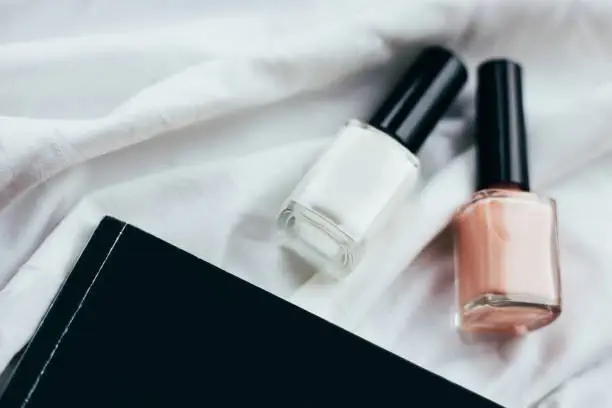
Shellac and Gel polish
Shellac or Gel are premixed liquid (monomers and oligomers), much like regular nail polish when applying, but you must cure them under a UV/LED lamp instead of air dry. Why? Because these components need “energy” to promote the chemical reaction, and that’s when the lamp comes in.
Gel polishes surprisingly appeared in the early 1980s. But UV light manufacturers were still in the dark just as much as nail techs, so the whole Gel application wasn’t popular until the 90s. Now, in some shops, it’s almost the standard polish because nobody has time to babysit you until your nails dry or top it off if you mess up.
So you may be rejected at the door if you ask for regular polish at certain shops; I’m not kidding.
Real Gel polishes last about three weeks or more; the hybrid Gel polishes last about two weeks.
When you call “Shellac,” it’s Gel polish but a hybrid trademark brand of CND. *Cough cough* It’s not the name of the service. Like girl, we know what you want when you say, “I want Shellac on my hands,” but it’s not the proper term. Plus, not every shop carries the CND Shellac brand.
The only difference is that Shellac is masked as “hybrid,” so their consistency is relatively thin vs. the other Gel polishes. That means two things; your color coats will look much better, lighter, similar to the traditional polish, and removal will be easier.
Not trying to brag, but I’m currently the only one I know who pulled a Gel polish application that lasted four months during the pandemic lockdown in 2020.
My Gel application does make your natural nails grow thicker and stronger, especially after being beaten up by other techs. But my service also takes twice the amount of time. I’m constantly sharpening my skills to trim down that time. I have plans to write a separate post about Gel polish. There’s so much about it.
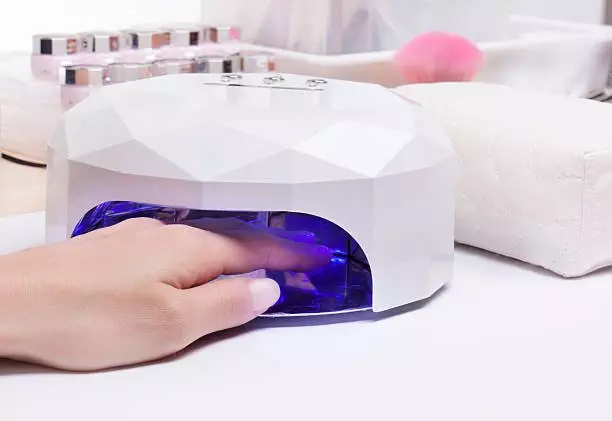
Acrylic vs. Hard Gel
It gets a little complicated here as it includes polymer (the powder) and monomer (the liquid) chemicals to form an enhancement, which is strong enough to “protect” your natural nails and build an extension or mold into various shapes.
So often, you’ll see nail techs wet their brush in the purple monomer (the liquid), then dip it into the powder. That forms the Acrylic. Then the tech will slap that onto your nail plate.
I say “protect” in quotation marks because we know acrylics wreck your natural nails rather than protecting them. Lol.
I’ll tell you a little secret. If you’re more observant, though, you’ll notice this. But you’re likely to break a few nails as soon as you finish your Acrylic because they need up to 2 days to harden completely. So during the first day or two, don’t do anything ridiculous with your nails.
You can thank me later for saving you some gas money and the hassle of coming back to fix your broken nails.
There is also Hard Gel, which is a lesser sister of the Acrylic family. I can see you smiling when I mention the word “Hard,” but it only means the Hard Gel is a lot more resistant, more durable than Soft Gel, and can’t be soaked off but filed down.
Its consistency is like honey and more flexible to work with. So you’ll feel lighter to wear, and it also looks more natural vs. Acrylic. Hard Gel is not the Gel polish (soft Gel) you usually put on as a color coat. But just like the Gel polish, you still cure them under ultraviolet light.
There was an incident that a male customer came in wanting Shellac, and my boss, Tracy, kept twisting his term and called it Gel; because Shellac is technically Gel polish. But man, he was so pissed off; he was yelling and stomping, “OMG. SHELLAC IS NOT GEL!!!”
And I immediately knew what he meant by that. He walked away with his two friends so fast. Lol.

Full set
It’s a full set of fake nails or a full set of Acrylic nails: same shit, different toilet. Sometimes nail techs use forms instead of tips, aka foil stickers instead of artificial plastic nails.
The nail extension can be sculpted over the form before it’s removed. You’ll build a much stronger enhancement with the form because everything is in one piece; there is no weak spot. But 90% of the nail salons will put tips on you for many reasons.
Tips are easier to use and already have the shape, so they’ll look more consistent across all fingers. When the tips become loose, your set will be compromised and can be broken. It’s the perfect time for you to go back to the shop for maintenance—aka cha-ching. Just Kidding!
The real reason is that customers aren’t accustomed to form. Like how many of you have ever done a complete set using forms instead of tips? Probably nada.
Plus, it can take a long time to build the form consistently and adequately vs. working with the tips. So there’s that.
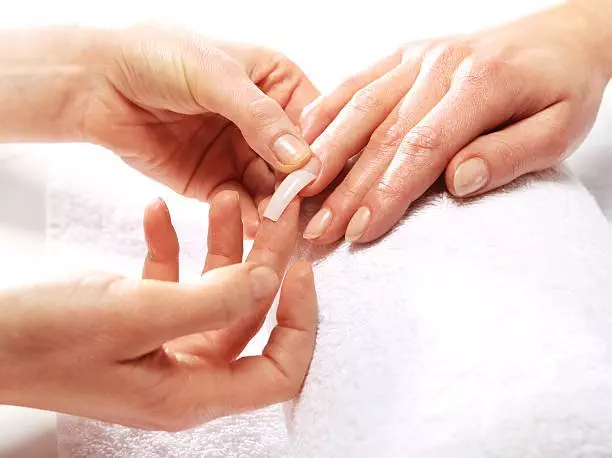
Fill
You only need a fill when you already have your Acrylic put on last time.
Why? Because after a while, your natural nails grow out, they’ll leave some space near the cuticle area. When this space expands, it just doesn’t look good.
That’s when you know you need to come in for an “Acrylic fill” to make everything look brand new again. We’d usually call “fill” for short. And the cost for a fill is about 1/3 of the price of a fresh set of Acrylic.
Most people decide to come back every 2-3 weeks for a filling, so they don’t end up breaking anything. It’s a fantastic time frame for both parties. It also gives us a chance to check on you and see if there’s any lifting.
Whatever you do, don’t wait out too long for your fill, say 6 weeks long, because it could potentially harm your nails if water leaks in.
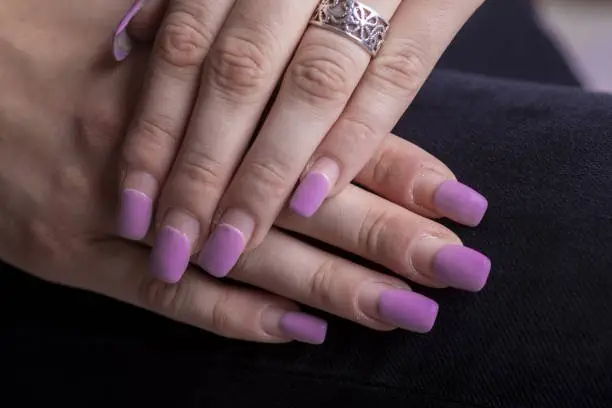
Dip
Dip powder is a “new” trend for sure, but mostly just social media popularizing it.
I’d say it’s in between Gel polish and Acrylic. It has the durability of Acrylic and the versatility of Gel polish. Aka lasts at least a month, and the bond is even stronger than Acrylic, providing better protection for brittle or weak nails.
The drawback is that removal is a pain in the rear area. Not to mention, dip powder has some common allergens, so not everybody can use it without irritating your nail bed. Hence, some salons don’t even include the dipping technique in their menus for numerous reasons.
But I think those salons are more concerned when it comes to sanitation when dipping your fingers in the same jar of color hundreds of other people already did.
It can sometimes look bulky when dipped three to five times to get the right shade. But it’s not usually the case.
If you want to run away from Acrylic, Dip powder is a gentler choice, especially if you like to keep your natural nails. Though, you can use Dip with artificial tips as well.
Some marketing agencies or nail techs will suggest Dip a “healthy” choice compared to Gel polish, but it’s just a bull load of crap. Lol. The Dip is a little more pricey compared to Gel or Acrylics, so they squeeze more out of you with the same effort.
If you or your tech doesn’t take care of your nails properly, they’re equally damaging, if not more. There’s no such thing as a healthy option in a nail salon. Lol. It’s just how your nail techs actually taking care of you. Welcome to the dark side! I sadly don’t have any cookies left. But the weed shop next door is just 12 steps away.

Conclusion
Over 2000-word article, and we barely scratch the surface. Lol.
There are a lot more nail terms out there for you to discover. But I find these to be standard based on my everyday experience.
Some people come in a shop and keep mentioning they need a manicure, but they want a full set instead. Girls! Wants and needs are two different things. Lol.
So you end up bouncing between nail techs when you don’t address the correct term because not all of us know everything from A to Z. Some may know it all but still refuse to do certain services for personal reasons or chemical reactions, allergies, etc.
It’s not only confusing as hell to us not knowing what you want, but it’s also annoying for you to be shoving off different stations in a shop. Make sure to get that term right, hon.











